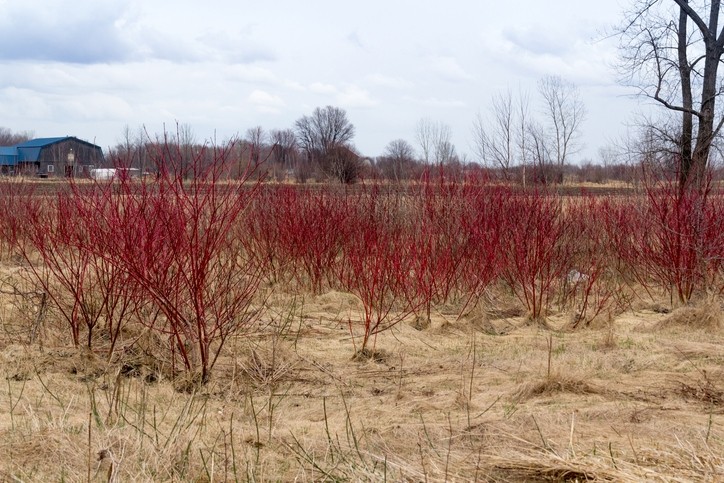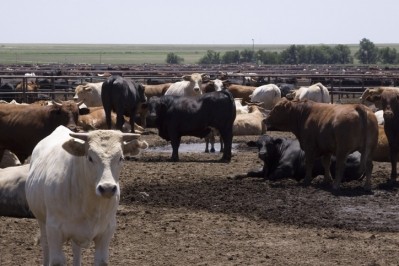Stop and eat the flowers: Dogwood-based additive may provide antibiotic alternative for feedlot cows

An international team of researchers from Canada, Egypt and China explored the use of red osier dogwood (ROD) as a silage replacement for cattle on a high grain diet.
The group published its work in the journal of Animal Feed Science and Technology.
“The objectives of this study were to investigate the effect of increasing substitution of barley silage for ROD in a high-grain diet on rumen pH and rumen fermentation, feed digestion in the total digestive tract, blood metabolites, and immune response in beef heifers,” the researchers said.
In the feeding trial, researchers found that dry matter intake increased quadratically as more ROD was added to the diets. However, it also increased dry matter digestibility and the concentration of haptoglobin (Hp) in plasma linearly, they said.
Ruminal NH3-N levels dropped linearly as amounts of the alternative ingredient increased in the diets.
“The present results confirmed our hypothesis that feeding ROD influence ruminal microbial populations, immunity and antioxidant status of cattle, and consequently impact feed digestion,” they said. “The present study also demonstrated advantage of feeding ROD over antibiotics (monensin and tylosin) in improving nutrient digestibility, with comparable immune response, suggesting the ROD can serve as an alternative to in-feed antibiotics in feedlot cattle.”
Why red osier dogwood in feed?
Red osier dogwood is a shrub native to North America and found in several parts of the world where it grows in wetlands, pastures and marginal land, said the researchers.
It is often eaten by wildlife and, when planted, can be harvested year round.
“The plant had been used as traditional medicine by Native America indigenous people to treat diarrhea, fever and skin problems,” they said. “Red osier dogwood is rich in bioactive compounds with total phenolic concentration varying between 40–220 g/kg depending on the growing season. The phenolics include anthocyanins, gallic acid, ellagic acid, quercetin, kaempferol, and cyanin.”
The plant’s phenolics contain antioxidant and antimicrobial elements, reported the authors.
Previous research found that the plant may lower incidence of mortality and diarrhea in rabbits and it has been posited as an antibiotic alternative for weaned pig diets.
“While the modes of action of in-feed subtherapeutic antimicrobials are not well defined, they have been hypothesized to promote growth by either modulating the gastrointestinal microbiota to enhance digestion and metabolism or by reducing intestinal mucosal inflammation through immunomodulation, and as a result providing more energy for net growth,” the researchers said. “Thus ROD may have some similar attributes to in-feed antimicrobials.”
During production, cattle can experience stressors including from high-grain diets, environmental conditions and management practices, they said.
Such events may promote oxidative stress, which surpasses antioxidant defenses and generates oxidative damage to biological molecules and disrupt normal physiology and metabolism.
However, improving cattle’s antioxidant capacity by feeding an ingredient like ROD is anticipated to improve its overall health and performance, they said.
“A recent farm demonstration carried out using 95 control heifers and 95 heifers fed 0.9 kg/d of ROD showed that average daily gain increased from 0.89 to 1.12 kg/d."
“We, therefore, hypothesized that feeding ROD would influence rumen microbial populations, immunity (intestine and body) and antioxidant status, and consequently impact feed digestion and immune response,” the researchers said.
Methods and materials
The ROD used in the feeding trial included leaves, bark and stem, which was dried, ground and mixed into the total mixed ration (TMR), the researchers said.
“The ROD consisted (dry matter [DM] basis) of 123 g/kg total phenolics including 5.4 g/kg gallic acid, 9.2 g/kg methyl gallate, 1.5 g/kg cathechin, 8.0 g/kg epicatechin, 8.3 g/kg rutin, 4.5 g/kg ellagic acid, and 7.2 g/kg quercetin,” they added.
During the feeding trial, five cannulated, beef heifers were given one of five diets for a 21-day period before being rotated to another diet, they said.
The feeding periods included 14 days of adaptation and 7 days for data and sample collection.
The diets included a control TMR with 150g/kg barley silage, 820g/kg dry-rolled barley grain and 30g/kg of a mineral and vitamin supplement, they said.
Other diets included the control along with an antibiotic supplement of 330mg monensin and 110mg tylosin per heifer, per day (ANT); or increasing amounts of ROD replacing the same amount of barley silage – at 30, 70 or 100g/kg ROD.
Feed offered and refusals were recorded daily and feed samples were collected for analysis weekly, the researchers said. Cattle were weighed at the start and end of each feed trial period.
Feed intake was calculated for the final 7 days of each trial period and apparent digestibility was established, they said. Fecal samples were collected for analysis during the last 5 days of each period.
Ruminal pH was checked from days 14 to 18 of each feeding period and rumen contents were collected, they said. Blood samples were gathered to check blood metabolites, antioxidant status and cell count on days 17 and 21.
Results
Overall, dry matter intake increased in a quadratic fashion as more ROD was substituted for barley silage, the researchers said.
A similar pattern was established for nutrients including organic matter, neutral detergent fiber (aNDF), acid detergent fiber (ADF) and crude protein.
“Compared with antibiotic group, feeding ROD resulted in greater intake and digestibility of DM, and greater [volatile fatty acids] VFA concentration,” they said. “These results indicate greater feed value of ROD versus barley silage in high-grain diets.”
Dry matter and organic matter digestibility also increased quadratically with the addition of more ROD in the diets, they said.
“Digestibility of aNDF and ADF tended to linearly increase with ROD inclusion levels,” they added.
Ruminal pH did not vary by diet, and there was no influence based on ROD inclusion to VFA concentration, the researchers said. Ruminal NH3-3 amounts tended to decline with more ROD in the diet while ruminal protozoa counts grew linearly.
“Concentrations of blood glucose, NEFA [non-esteriefied fatty acids] and urea N [nitrogen] did not differ with increasing concentrations of ROD in the diet, whereas blood NEFA concentration tended to be lower for ROD diets than ANT,” they said. “Increasing the substitution of ROD for silage increased counts of red blood cells, hemoglobin (Hb) concentration and hematocrit (Ht). Numbers of WBC, lymphocytes, monocytes and granulocytes linearly increased with increasing ROD.”
Adding increasing amounts of ROD to the feeds expanded amounts of Hp and serum amyloid A (SAA), along with blood antioxidant capacity and superoxide dismutase, they said.
Superoxide dismutase activity in ROD inclusive diets tended to be higher than with the ANT diet.
“Feeding ROD potentially improves immune status and antioxidant activity in finishing beef heifers,” the researchers said. “Beef cattle fed ROD performed better or at least equal to antibiotics currently used in beef cattle rations and it could be used as a natural alternative for beef cattle production.”
Source: Animal Feed Science and Technology
Title: Feeding red osier dogwood (Cornus sericea) to beef heifers fed a high-grain diet affected feed intake and total tract digestibility
Authors: L. Wei, W. Gomaa, B. Ametaj, T. Alexander, W. Yang
DOI: doi.org/10.1016/j.anifeedsci.2018.11.006














